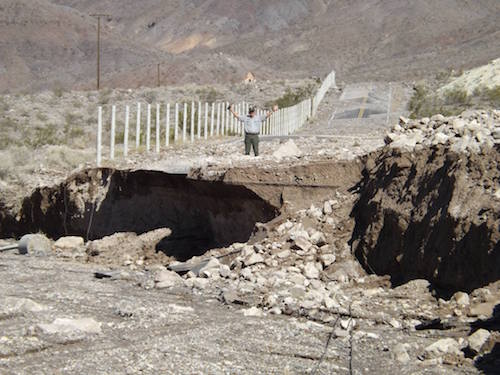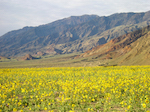 Without rain there can be no wildflowers, so we here at Deathvalley.com want to thank Ms. Schultz for sharing a photo she caught of a rare full double rainbow last October on highway 190 (full size below). We are fairly certain that this rainbow was part of the storm that caused so much havock and yet is directly responsible for this year's superbloom.
Without rain there can be no wildflowers, so we here at Deathvalley.com want to thank Ms. Schultz for sharing a photo she caught of a rare full double rainbow last October on highway 190 (full size below). We are fairly certain that this rainbow was part of the storm that caused so much havock and yet is directly responsible for this year's superbloom.
 In an ominous preamble to the expected El Nino this year across California, a series of severe thunderstorms passed over Death Valley National Park, knocking down power lines and stranding park rangers and visitors alike in the Ubehebe Crater in the north end of the park.
In an ominous preamble to the expected El Nino this year across California, a series of severe thunderstorms passed over Death Valley National Park, knocking down power lines and stranding park rangers and visitors alike in the Ubehebe Crater in the north end of the park.
Feet of mud has been reported at Scotty’s Castle Visitor Center, the exterior of which is surrounded by mud and debris. Roads across the national park were closed and Mesquite Campground was evacuated Sunday night.
California 190 remains open, and Stateline Road / Bell Vista to Pahrump is open, but still has flowing water on the California side and large vehicles may have trouble with this road.
CA 127 is open, but Badwater Road (Highway 178), Scotty’s Castle Road (North Highway, West Side Road, Big Pine-Death Valley Road and Racetrack Road are all closed.
For a current update on road conditions at Death Valley national park, visit the National Park’s Page or Like their Facebook page.
 Death Valley Natural History Association has reported one of the earliest blooms in recent memory in Death Valley National Park. Heavy early rains (and the flooding it has caused) seems to have put the delicate and ephemeral desert wildflowers on show as they take advantage of the record moisture.
Death Valley Natural History Association has reported one of the earliest blooms in recent memory in Death Valley National Park. Heavy early rains (and the flooding it has caused) seems to have put the delicate and ephemeral desert wildflowers on show as they take advantage of the record moisture.
Peak viewing generally occurs in late-February through mid-April, but wildflowers can be seen in the higher elevations of the even in early summer.
The best viewing occurs in the most accessible areas of Death Valley, some of the most memorable areas in the past easily viewed from the highways and roads that cross the national park.
The National Park service maintains a webpage with regular updates about wildflower activity in Death Valley, you can view it by clicking here.
More rainfall is anticipated in what's expected to be a highly active El Nino year. It's possible that we could even see a super bloom this year, an event which hasn't happened since 2005 and which carpeted the infamously dry valley in brilliant color.
The Death Valley Natural History Association sells wildflower books, brochures and more. Proceeds benefit Death Valley National Park.
 Over the past few weeks there’s been one topic on the minds of Mojave Desert residents: it’s green.
Over the past few weeks there’s been one topic on the minds of Mojave Desert residents: it’s green.
Gentle rainstorms lasting several days have moved slowly across the desert over the past few months, leaving a particular lush carpet of green that is now starting to come up golden, purple, and orange.
The Death Valley Natural History Association has reported excellent conditions in Death Valley, with David Becker, the executive director of the association, suggested that, while “the weather over the next several weeks will be the determining factor, but from what I’m seeing on the ground, this could be the best year we’ve had since the spectacular displays of 2005.”
The season of 2004-2005 (see photo) was an unusually wet one, leading to several ephemeral lakes and spectacular wildflowers that painted the normally stark landscape in shades of yellow and purple.
Should the weather remain mild, with low wind speeds, and regular rain showers, it’s possible that Death Valley could, once again, be blanketed in bright carpets of color.
To keep updated about wildflower conditions you can call the Wildflower Hotline at (760) 767-4684 or like national park’s facebook page.

